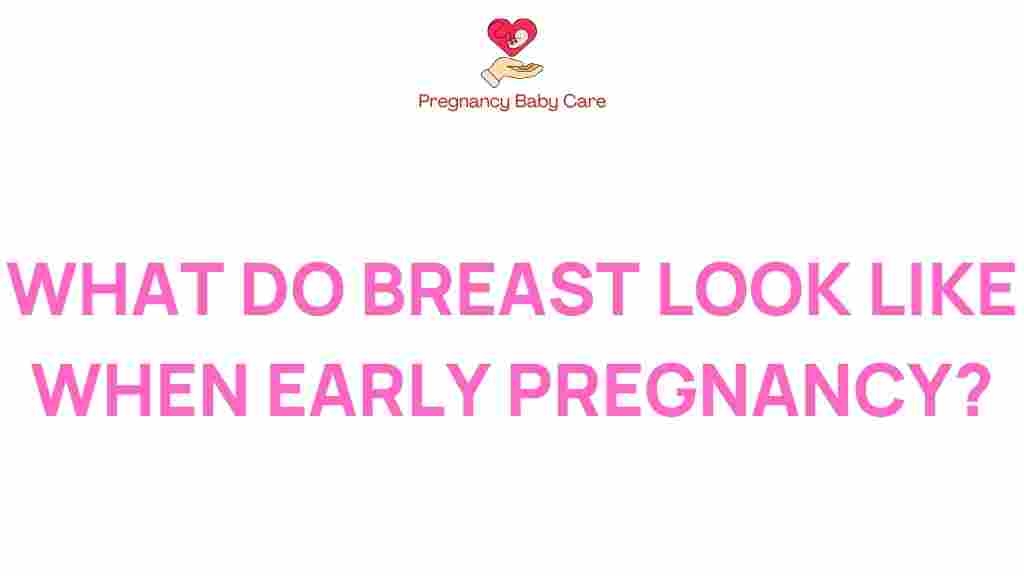Unveiling the Changes: What Do Breasts Look Like in Early Pregnancy?
Early pregnancy is a fascinating time filled with numerous physical and emotional transformations. One of the most noticeable changes women experience during this period is in their breasts. Understanding these changes can help expectant mothers prepare for the journey ahead, both physically and mentally. In this article, we’ll explore the various breast changes that occur in early pregnancy, the underlying hormonal shifts, and their significance in maternal health and breastfeeding preparation.
Understanding Breast Changes in Early Pregnancy
During early pregnancy, a woman’s body undergoes several transformations, largely driven by hormonal changes. Here are some key aspects of breast changes during this stage:
- Increased Size: Many women notice that their breasts begin to swell and feel heavier. This is due to increased blood flow and the development of milk-producing glands.
- Changes in Shape: Breasts may become rounder or fuller as the body prepares for breastfeeding.
- Sensitivity: Increased sensitivity and tenderness are common, making even the lightest touch feel uncomfortable.
- Color Changes: The areolas often darken in color, and the veins may become more prominent, reflecting the increased blood supply.
- Texture Changes: The skin around the nipples may become more bumpy due to Montgomery glands becoming more pronounced.
The Role of Hormonal Shifts
The changes in breasts during early pregnancy are largely due to significant hormonal shifts. Here’s how the hormones play a vital role:
- Estrogen: This hormone increases during pregnancy, leading to the growth of breast tissue and milk ducts.
- Progesterone: It helps prepare the breasts for milk production and influences the sensitivity and fullness of the breasts.
- Prolactin: This hormone is crucial for milk production and can lead to changes in breast size and feel.
These hormonal shifts are essential not just for the physical changes but also for maternal health, as they prepare the body for breastfeeding once the baby arrives.
What to Expect: A Timeline of Breast Changes
Understanding the timeline of breast changes can help pregnant women anticipate and understand their bodies better:
- Weeks 1-4: Some women may notice slight changes in their breasts, including increased sensitivity and a feeling of fullness.
- Weeks 5-8: Breast growth becomes more noticeable, and tenderness may increase. The areolas may also darken.
- Weeks 9-12: By this stage, most women will experience significant changes in size and sensitivity. Breasts may feel heavier, and veins may become more visible.
Breastfeeding Preparation
One of the critical aspects of breast changes in early pregnancy is their role in preparing for breastfeeding. Here’s how early pregnancy contributes to effective breastfeeding:
- Developing Milk Ducts: The changes in breast tissue help to establish a robust system for milk production.
- Increased Blood Flow: Enhanced blood circulation ensures that the breasts are adequately supplied with nutrients needed for milk production.
- Emotional Readiness: Understanding these physical changes can help mothers mentally prepare for the breastfeeding journey.
Common Concerns and Troubleshooting Tips
As exciting as early pregnancy can be, it can also be filled with uncertainties and concerns. Here are some common issues and tips on how to address them:
- Excessive Tenderness: If the sensitivity becomes unbearable, consider wearing a supportive bra that minimizes movement.
- Sudden Changes: If you experience sudden or extreme changes, consult with a healthcare provider to ensure everything is progressing normally.
- Skin Irritation: Use gentle, hypoallergenic soaps and moisturizers to soothe sensitive skin.
It’s essential to listen to your body and seek medical advice if you have any concerns regarding your breast changes or overall pregnancy symptoms.
Maintaining Maternal Health during Early Pregnancy
Maternal health is crucial during early pregnancy, especially as your body undergoes significant changes. Here are some tips for maintaining your health:
- Nutrition: Focus on a balanced diet rich in vitamins and minerals to support both maternal and fetal health.
- Hydration: Stay well-hydrated to support increased blood volume and overall body function.
- Regular Exercise: Engage in moderate exercise as approved by your healthcare provider to promote overall well-being.
- Regular Check-ups: Schedule regular prenatal visits to monitor the health of both mother and baby.
Taking care of your health during early pregnancy will aid in a smoother transition as your body prepares for motherhood.
Conclusion
In conclusion, early pregnancy is a time of remarkable transformation, particularly concerning breast changes. Recognizing these changes and understanding their origins in hormonal shifts can help expectant mothers prepare for the challenges and joys of motherhood. By focusing on maternal health and being aware of the signs of body transformation, women can navigate this exciting journey with confidence.
For more information on maternal health during pregnancy, check out this comprehensive guide on pregnancy symptoms. If you have any concerns about your breast changes, don’t hesitate to speak with your healthcare provider to ensure a healthy pregnancy.
Remember, every woman’s experience is unique, and embracing your body’s changes is part of the beautiful journey of bringing new life into the world.
This article is in the category Pregnancy and created by PregnancyBabyCare Team
